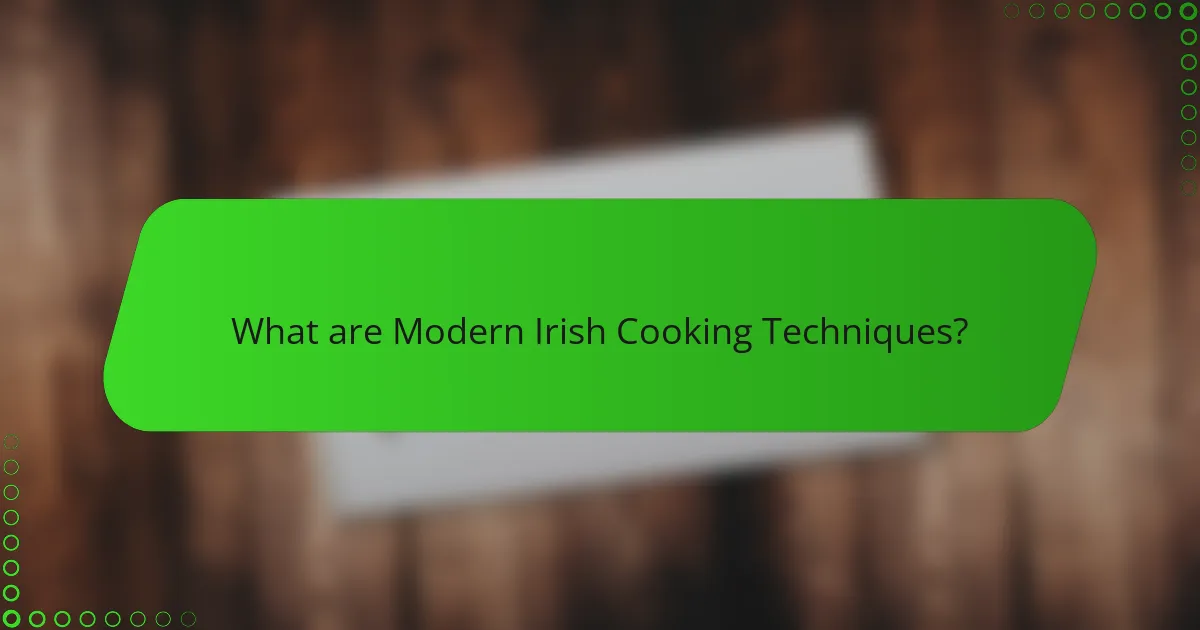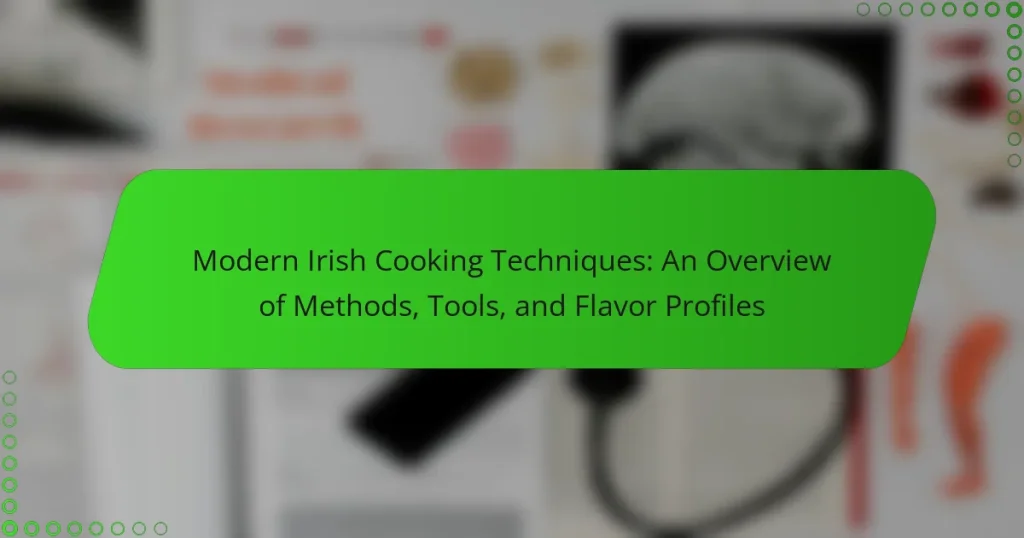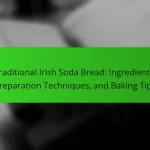Modern Irish cooking techniques encompass methods such as slow cooking, braising, roasting, sous-vide, and fermentation, all of which prioritize the use of local, seasonal ingredients. This cuisine is characterized by hearty flavors from traditional ingredients like lamb, beef, root vegetables, and seafood, enhanced by herbs and dairy products. The article explores how these techniques and flavor profiles reflect a blend of traditional and contemporary practices, emphasizing the importance of fresh, high-quality ingredients. Additionally, it provides practical tips for applying these methods at home, highlighting tools and classic recipes that support modern adaptations while maintaining cultural significance.

What are Modern Irish Cooking Techniques?
Modern Irish cooking techniques include methods such as slow cooking, braising, and roasting. These techniques emphasize the use of local, seasonal ingredients. For example, slow cooking allows flavors to develop in traditional stews like Irish lamb stew. Braising is often used for meats, ensuring tenderness and rich flavor. Roasting is common for vegetables and meats, enhancing their natural sweetness. Additionally, modern Irish cuisine incorporates techniques like sous-vide and fermentation. These methods reflect a blend of traditional and contemporary culinary practices. The resurgence of interest in Irish food has led to innovation in these techniques, ensuring they remain relevant today.
How have traditional Irish cooking methods evolved?
Traditional Irish cooking methods have evolved significantly over the years. Historically, Irish cooking relied on simple techniques such as boiling, baking, and stewing. These methods were influenced by the availability of locally sourced ingredients. The introduction of new cooking technologies has transformed these traditional practices. For instance, modern appliances like ovens and induction cooktops have replaced open fires and traditional ranges. Additionally, globalization has introduced diverse culinary influences, leading to the incorporation of international flavors and techniques. Contemporary Irish chefs often blend traditional recipes with modern plating and presentation styles. This evolution reflects a shift towards more innovative and varied culinary experiences in Irish cuisine.
What key influences have shaped modern Irish cuisine?
Modern Irish cuisine has been shaped by historical events, cultural exchanges, and local ingredients. The Great Famine in the 19th century led to a significant shift in food sourcing and preparation. Immigration brought diverse culinary traditions, influencing flavor profiles and cooking methods. The Celtic Tiger period in the late 20th century introduced global cuisines and modern dining trends. Increased focus on local and sustainable ingredients has also transformed traditional dishes. Additionally, the revival of artisanal food production has enhanced the quality of Irish cuisine. These factors collectively define the evolution of modern Irish cooking.
How do contemporary Irish chefs reinterpret classic dishes?
Contemporary Irish chefs reinterpret classic dishes by integrating modern cooking techniques and global flavors. They often utilize sous-vide cooking to enhance texture and flavor. Seasonal and local ingredients are emphasized to reflect contemporary sustainability practices. Chefs may deconstruct traditional recipes, presenting them in innovative ways. For example, a classic Irish stew might be served as a refined plate with individual components. Techniques like fermentation and pickling are also employed to add complexity. Additionally, fusion cuisine influences can be seen, blending Irish ingredients with Asian or Mediterranean flavors. This evolution keeps traditional dishes relevant in today’s culinary landscape.
What are the foundational methods used in modern Irish cooking?
The foundational methods used in modern Irish cooking include boiling, baking, and roasting. Boiling is commonly used for preparing traditional staples like potatoes. Baking is essential for making bread, which is a significant part of Irish cuisine. Roasting is often applied to meats, enhancing their flavors and textures. These methods reflect Ireland’s agricultural heritage and seasonal ingredients. The use of fresh produce and locally sourced meats is a hallmark of modern Irish cooking. Each method contributes to the development of rich flavors, typical in Irish dishes.
What are the primary cooking techniques employed?
The primary cooking techniques employed in modern Irish cooking include boiling, baking, roasting, and sautéing. Boiling is often used for preparing vegetables and traditional dishes like Irish stew. Baking is a common method for making bread and desserts, often utilizing traditional recipes. Roasting is applied to meats and root vegetables, enhancing their flavors through caramelization. Sautéing is frequently used for quick cooking of meats and vegetables, allowing for the development of rich flavors. These techniques reflect both historical practices and contemporary culinary trends in Ireland.
How do these techniques enhance flavor and texture?
Modern Irish cooking techniques enhance flavor and texture through methods such as sous-vide, fermentation, and smoking. Sous-vide cooking allows for precise temperature control, ensuring meats are tender and juicy. Fermentation develops complex flavors and improves digestibility, as seen in traditional breads and pickled vegetables. Smoking infuses ingredients with rich, woody flavors, enhancing the overall taste profile. Techniques like emulsification create smooth textures in sauces and dressings, contributing to a refined mouthfeel. Each method leverages scientific principles to elevate the culinary experience.
What tools are essential for modern Irish cooking?
Essential tools for modern Irish cooking include a sturdy chef’s knife, a cast iron skillet, and a heavy-bottomed pot. A chef’s knife is crucial for precise chopping and slicing of ingredients. A cast iron skillet provides excellent heat retention for searing and frying. A heavy-bottomed pot is ideal for slow cooking and stews, which are staples in Irish cuisine. Additionally, a wooden spoon is essential for stirring and mixing. A food processor can simplify tasks like chopping herbs or making sauces. These tools enhance efficiency and ensure the authenticity of traditional Irish dishes.
Which kitchen tools are commonly used by Irish chefs?
Irish chefs commonly use a variety of kitchen tools essential for their cooking. These tools include knives, pots, pans, and wooden spoons. High-quality chef’s knives are crucial for precision cutting. Cast iron skillets are favored for their heat retention and versatility. Heavy-bottomed saucepans are preferred for making sauces and soups. Additionally, colanders are used for draining vegetables and pasta. Measuring cups and spoons ensure accurate ingredient portions. Food processors assist in chopping and blending ingredients efficiently. These tools reflect traditional and modern Irish cooking practices, enhancing both technique and flavor.
How do these tools facilitate specific cooking methods?
Cooking tools facilitate specific cooking methods by providing the necessary equipment to achieve desired results. For example, a sous vide precision cooker allows for precise temperature control, ensuring even cooking throughout. A cast iron skillet retains heat well, making it ideal for searing meats and achieving a crispy crust. Steamers help in cooking vegetables while preserving their nutrients and color. Blenders enable the creation of smooth sauces and soups, enhancing flavor integration. Each tool is designed to optimize a particular method, improving efficiency and consistency in the cooking process. The correct use of these tools can elevate the quality of the final dish significantly.

What flavor profiles define modern Irish cuisine?
Modern Irish cuisine is characterized by a blend of hearty, rustic flavors and fresh, seasonal ingredients. Common flavor profiles include earthy notes from root vegetables like potatoes and carrots. Additionally, the use of herbs such as parsley and thyme adds brightness. Seafood flavors are prominent, reflecting Ireland’s coastal geography. Traditional meats, such as lamb and beef, provide rich, savory tastes. Dairy products, particularly butter and cheese, contribute creaminess and depth. The incorporation of global influences has introduced spices and flavors, enhancing traditional dishes. Overall, modern Irish cuisine balances tradition with innovation, creating a diverse culinary experience.
How do local ingredients influence flavor profiles?
Local ingredients significantly influence flavor profiles by providing distinct tastes and aromas unique to a region. These ingredients often reflect the local climate, soil, and agricultural practices. For instance, herbs like wild garlic or seaweed add specific umami and earthy notes to dishes. Seasonal produce, such as root vegetables, can enhance sweetness or earthiness, depending on the harvest time. Furthermore, local meats and dairy products often have unique flavor characteristics due to the animals’ diets and farming methods. Historical cooking practices in Ireland, such as using smoked fish or fermented foods, also shape flavor profiles. The use of local ingredients fosters a connection to cultural heritage, enhancing the authenticity of modern Irish cuisine.
What are the most popular ingredients in modern Irish cooking?
The most popular ingredients in modern Irish cooking include potatoes, cabbage, beef, lamb, and seafood. Potatoes are a staple, often used in dishes like colcannon and boxty. Cabbage is commonly featured in traditional recipes and salads. Beef, particularly in stews and roasts, showcases the rich farming heritage. Lamb is favored for its flavor and is often used in classic Irish dishes. Seafood, especially salmon and shellfish, highlights Ireland’s coastal resources. These ingredients reflect both historical and contemporary culinary practices in Ireland.
How do seasonal variations affect ingredient availability?
Seasonal variations significantly affect ingredient availability. Different seasons bring specific crops and products to maturity. For example, spring offers fresh herbs and leafy greens. Summer provides a bounty of fruits and vegetables, such as tomatoes and berries. Autumn yields root vegetables and grains, while winter often limits options to stored or preserved foods. This cyclical availability influences menu planning and ingredient sourcing in modern Irish cooking. Chefs adapt their techniques and flavor profiles based on what is seasonally available. Seasonal sourcing encourages freshness and sustainability in culinary practices.
What role do herbs and spices play in modern Irish dishes?
Herbs and spices enhance the flavor and aroma of modern Irish dishes. They contribute depth and complexity to traditional recipes. Common herbs include parsley, thyme, and dill. Spices like black pepper and mustard seeds are also frequently used. These ingredients are essential for balancing flavors in hearty meals. They can transform simple ingredients into flavorful dishes. The use of herbs and spices reflects a growing trend in modern Irish cuisine towards innovation. This trend incorporates global influences while respecting traditional Irish flavors.
Which herbs and spices are frequently used?
Common herbs and spices used in modern Irish cooking include parsley, thyme, rosemary, and dill. These herbs enhance flavor and complement traditional Irish dishes. Spices such as black pepper, nutmeg, and paprika are also frequently incorporated. Parsley is often used for garnishing and flavoring. Thyme and rosemary are popular for seasoning meats and stews. Dill is commonly paired with fish dishes. Black pepper is a staple seasoning in many recipes. Nutmeg adds warmth to various baked goods. Paprika is used to impart color and flavor to soups and sauces.
How do they complement traditional Irish flavors?
Modern Irish cooking techniques enhance traditional Irish flavors through innovative methods and ingredients. Techniques such as sous-vide cooking preserve the integrity of traditional ingredients while intensifying their flavors. The use of fermentation adds depth and complexity, complementing classic dishes like colcannon or Irish stew. Incorporating global spices and herbs introduces new dimensions without overshadowing the foundational Irish palate. For instance, the addition of smoked paprika can elevate a traditional fish pie. These modern approaches maintain the essence of Irish cuisine while providing fresh interpretations that appeal to contemporary tastes.

How can one effectively apply modern Irish cooking techniques at home?
To effectively apply modern Irish cooking techniques at home, one should focus on using fresh, locally sourced ingredients. Modern Irish cuisine emphasizes seasonal produce and high-quality meats. Techniques such as sous-vide cooking and fermentation are popular in contemporary recipes. Incorporating traditional methods like baking soda bread can also enhance authenticity. Utilizing tools like cast iron pans and immersion blenders aids in achieving desired textures and flavors. Experimenting with flavor profiles, such as pairing seafood with Irish whiskey, can elevate dishes. Familiarizing oneself with classic Irish recipes provides a strong foundation for modern adaptations. Understanding the cultural significance of ingredients enriches the cooking experience.
What tips can enhance the home cooking experience?
To enhance the home cooking experience, prioritize organization and preparation. Start by gathering all ingredients and tools before cooking. This reduces stress and improves efficiency. Next, invest in quality kitchen tools. Sharp knives and sturdy pots can significantly affect cooking outcomes. Experiment with different flavors and techniques to keep meals interesting. Incorporating seasonal ingredients can also enhance taste and freshness. Take time to understand cooking methods. Mastering techniques like sautéing or braising can elevate dishes. Lastly, embrace mistakes as learning opportunities. This mindset fosters growth and creativity in the kitchen.
What common mistakes should be avoided in modern Irish cooking?
Common mistakes in modern Irish cooking include overcooking traditional ingredients. This can lead to loss of flavor and texture. Another mistake is neglecting the use of fresh, local produce. Fresh ingredients enhance the authenticity of dishes. Additionally, improper seasoning can diminish the overall taste. Balancing flavors is crucial for a successful dish. Failing to embrace traditional methods can also be problematic. Techniques like slow cooking are essential for depth of flavor. Lastly, overlooking the importance of presentation can affect the dining experience. Visual appeal is significant in modern culinary practices.
How can one experiment with flavors while staying true to Irish roots?
One can experiment with flavors while staying true to Irish roots by incorporating traditional ingredients in innovative ways. Use staple Irish ingredients like potatoes, cabbage, and lamb as a base. Combine these with contemporary techniques such as sous-vide or fermentation. For instance, fermenting cabbage can create a unique twist on colcannon.
Additionally, explore global spices while maintaining Irish elements. For example, adding cumin to a traditional Irish stew can enhance its depth without losing its essence.
The use of local, seasonal produce is also vital. This practice aligns with the traditional Irish ethos of using what is available.
Experimenting with flavor pairings can yield exciting results. Pairing Irish whiskey with chocolate can create rich desserts that reflect both heritage and modern taste.
These methods allow for creativity while honoring the foundational aspects of Irish cuisine.
Modern Irish cooking techniques encompass a variety of methods such as slow cooking, braising, and roasting, emphasizing local and seasonal ingredients. The evolution of traditional Irish cooking has integrated contemporary practices like sous-vide and fermentation, reflecting a blend of historical and modern influences. Key tools essential for these techniques include chef’s knives, cast iron skillets, and heavy-bottomed pots, which facilitate various cooking methods. The article also explores flavor profiles defined by popular ingredients like potatoes, beef, and seafood, while highlighting the role of herbs and spices in enhancing traditional dishes. Overall, it provides practical tips for applying these techniques at home, encouraging experimentation while respecting Irish culinary roots.


